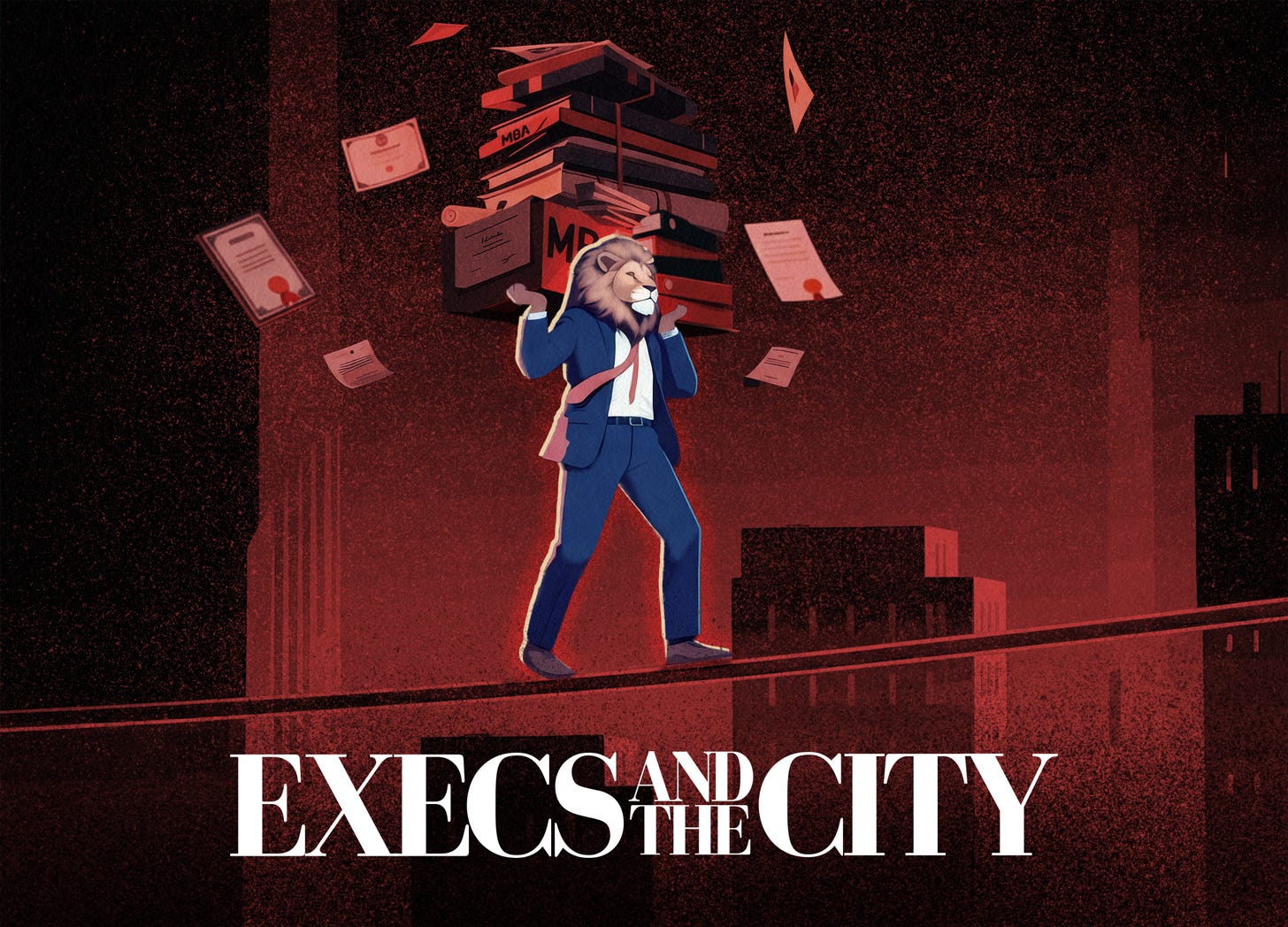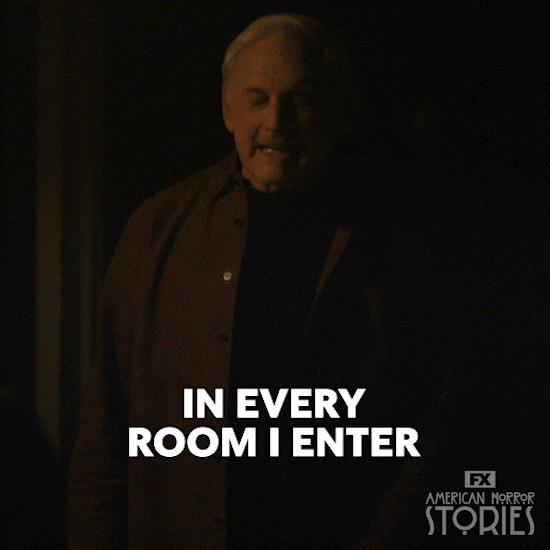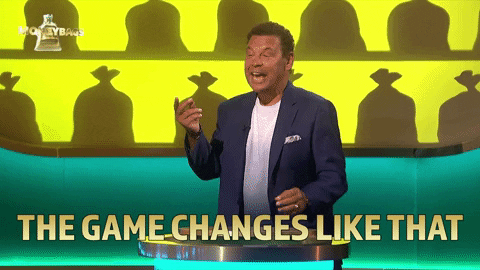The Hidden Career Mistake Too Many Executives Make
Why the two-thirds approach to persuasion limits your impact—and the missing piece that transforms careers.
Welcome to Execs and the City, where we reveal how elite leaders create an unfair advantage in their careers. Paid subscribers get exclusive perks like our complete toolkit, including full access to our guides and powerful career tools.
A highly credible SVP with fifteen years of flawless performance reviews at a Fortune 500 sits across from the hiring committee, certain this C-suite role is theirs.
Their presentation is immaculate.
Their business case is bulletproof.
Their credentials check every box on the job description.
Three weeks later, they watch someone with a less impressive resume walk into that corner office—along with 2x the compensation.
That’s the 4th time in the last 3 years this has happened.
Sound familiar?
You've seen this pattern before and I bet you know exactly how it feels.
So what do most executives do when they hit this wall?
They double down on what got them this far.
They shell out $100K for MBA programs from top-10 business schools.
They hire expensive consultants to optimize their resume and LinkedIn presence.
They collect certifications and build more detailed business cases, craft more logical arguments, and polish their presentations until they shine.
But too often, I’m afraid they are barking up the wrong tree.
They're trying to solve an influence problem with more credentials.
I’ve noticed that the most common stall point for executives is approximately $350,000 annually—which is typically at the Director and VP level in Silicon Valley.
Yes, that type of earning is nothing to scoff at; however, I can also understand that it feels absolutely stifling. Especially considering how hard you have to grind (and how much Uncle Sam rakes in) from maintaining that type of high-stress W2.
You know you're capable of more.
You can see the next level clearly. But something crucial is missing, and you can't quite put your finger on what it is.
The something that's missing isn't another degree or a shinier resume.
Most executives are unknowingly playing with only two-thirds of the influence toolkit that actually drives decisions at the highest levels.
And that missing third?
While many don't completely ignore the emotional component, they often use it subconsciously or in an underdeveloped way, which is a critical mistake that limits their full influence.
It's often the difference between getting passed over and getting the role—plus the compensation increase that comes with it.
The Two-Thirds Trap
A few months ago, I had a strategy session with a notably accomplished leader—someone I'd worked with before who came highly recommended.
We were brainstorming how to help them build an argument to get other C-suite executives to care about their design team.
To take design seriously.
You know how there are phases of a business where the "golden child" always gets the attention?
In the early days, it's engineering and product teams. They get all the love. Then it's sales and revenue teams.
Then that's usually it.
HR, Operations, Marketing, Design, Customer Success—they're necessary to make a business hum, but too often, they're treated like cost centers on the P&L and have an uphill battle fighting for resources.
If you aligned your career with one of those functions, you know exactly what I mean.
My client, a highly respected design executive, was all too familiar with walking in those shoes. Here we had a credible leader with a logical track record of excellent performance.
Ethos? Check. Logos? Double check.
It was enough to win the job, but not enough to win support for their new role or get the resources they needed to uplevel the team.
As we talked through their challenge, I realized what was missing.
They had mastered credibility and logic—but they were completely ignoring the emotional connection with other decision-makers.
They needed to arm those leaders with information that would be echoed repeatedly, creating a compelling case for design that went beyond spreadsheets and PowerPoints.
This conversation aligns with something I've been developing through my years of coaching—perhaps I'll call it the Rhetorical Hierarchy Theory.
I've been testing it with recent clients with notable success, and it's built on a refresher of Aristotelian principles.
Ethos is mastery of credibility.
Logos is mastery of logic.
Pathos is mastery of emotion.
Here's the pattern I keep seeing with high performers:
Early Career (Manager/Director level): ETHOS mastery—reliably ticking the boxes.
Mid-Career (Director/VP level): ETHOS + LOGOS—reliably ticking the boxes that impact the business.
Executive Level (VP/C-Suite): ETHOS + PATHOS + LOGOS—reliably ticking the boxes that impact the business and the people.
Many executives never make that final leap because they've been conditioned to see emotion as unprofessional.
They're voluntarily handicapping themselves.
I should know.
I won several leadership roles I wasn't qualified for on paper—no college degree, no pedigreed background. I couldn't compete on pure credentials or logic. I had to master the psychology of conversation and influence that most "qualified" candidates completely ignore.
Fortunately, my clients have the exact opposite challenges and that yin and yang has helped drive my business forward.
The difference between getting passed over and getting the role often comes down to understanding this missing piece.
Aristotelian Tripod Problem
Aristotle identified three modes of persuasion over 2,000 years ago: ethos (credibility), pathos (emotion), and logos (logic).
I’ve noticed that many modern executives tend to lean into two of Aristotle’s principles naturally while treating the third like it's radioactive.
Here's why this happens.
Type A personalities tick boxes, get grades, do as they're told, and keep emotions in check.
This serves them brilliantly while climbing the corporate ladder. They became tactical masters—slaying at design, coding like monsters, slinging sales like the best of them. This aligns with Ethos—their work becomes credible.
As they advance, they learn to tie their work to business outcomes—which aligns with Logos. They can now measure impact across departments, making them high-potentials (HIPOs) to their leaders. Director and VP roles follow naturally through pure ethos and logos mastery.
But here's where it gets interesting.
When you start observing what the top executives are doing—the seven-figure+ earners, not just any SVP or C-suite leader in title only—you'll find a harmony of ethos, pathos, AND logos.
The best must master emotional depth to influence entire organizations for transformational results.
It’s got me thinking, can you only break the glass ceiling in your career if you master all three pillars of persuasion? Is that what it takes to master influence?
Meanwhile, most executives remain trapped in what I call the "credibility-logic comfort zone."
They can build impressive presentations and bulletproof business cases, but they can't create the emotional buy-in that transforms evaluators into advocates—and too often they communicate like robots in the process.
That’s the ceiling you need to break.
We've been professionally conditioned to believe that emotion has no place in "serious" business decisions. Rhetoric became a dirty word—associated with political manipulation and corporate gaslighting.
So we eliminated the most powerful third of our influence toolkit.
Yikes.
Too many miss that at the executive level, it's more about who you know than what you know.
And if you can't connect emotionally, you can't network effectively.
You're stuck relying on credentials alone while others build the relationships that really drive the best career opportunities.
More people should understand that hiring and promotion decisions at the executive level aren't necessarily logical.
The most credible person doesn't always win.
Research shows that hiring managers default to "safe" choices due to loss aversion and status quo bias. When they take a "chance" on someone unconventional, their reputation is on the line.
However, logic and credibility don’t overcome this psychological barrier—emotion does.
The executives who master pathos understand something crucial.
Many people don't make decisions based on who's most qualified on paper.
They make decisions based on who makes them feel confident, smart, and excited about their choice.
Plenty of executives are highly credible and logical leaders—but also emotional duds. Especially in many tech cultures where this type of behavior is rewarded. That’s not a differentiated position to take.
They wonder why less "qualified" people keep getting the roles they want—so they invest even more time and energy in activities that build their logic and credibility factors—never realizing they're voluntarily playing with a handicapped influence toolkit.
The rare executives who master all three—ethos, pathos, and logos—don't just climb the ladder. They redefine what's possible in their careers.
They turn perceived disadvantages into competitive advantages.
They make it the purchasing agent OR the hiring manager's idea to choose them BECAUSE they're different, not despite it.
Influence is the missing piece that transforms careers. And it's hiding in plain sight.
Why Your Brain Works Against You
The human brain is wired to sabotage unconventional hiring decisions, even when those decisions would be objectively better for the business.
Here are some tips to level the playing field for you.
Carnegie's Reputation Psychology
Dale Carnegie identified something brilliant in "How to Win Friends and Influence People": give people a good reputation to withhold, and they'll fight to live up to it.
We use this insight all the time when running the gauntlet of challenging executive interview cycles or deal reviews when closing a quarter defining deal.
When you tell someone they're innovative, forward-thinking, or different, you create psychological pressure for them to prove you right. It's called consistency bias—humans have a deep need to act in ways that align with how they see themselves and how they believe others see them.
Here's an example of how this works in executive conversations: "You strike me as someone who isn't just hiring for the status quo—perhaps that's why you're interested in speaking with me."
You've just positioned them as innovative.
Now they have to act consistently with that identity.
If they choose the conventional candidate, they're contradicting their own innovative self-image that you helped them reinforce. You've made it psychologically easier for them to choose you BECAUSE you're different.
This cascades beautifully.
Once they accept the identity ("I am innovative"), they must logically accept your next premise ("innovative people value different perspectives").
You've transformed the conversation from proving you fit their criteria to making them prove they're as forward-thinking as they believe.
While we focused on "innovative" here, there are many other positive reputations you can give someone. Here are a few examples of reputations top executives would love to have said about them:
Visionary: Frame them as a leader who sees opportunities others miss and is not afraid to challenge the status quo.
Strategic: Position them as a deeply strategic thinker who can connect the dots between seemingly unrelated ideas.
Transformative: Compliment their ability to have a lasting, transformative impact on the companies they lead, not just temporary gains.
Decisive: Acknowledge them as a leader known for making bold, clear decisions rather than getting stuck in analysis paralysis.
Fair: Give them a reputation for being a leader who ensures equitable treatment and opportunities for everyone on their team.
Trustworthy: Frame them as someone whose integrity is so well-known that people trust their judgment and word implicitly.
Principled: Compliment their reputation for standing by their values and making choices that are not only profitable but also ethical.
By using these reputations, you create a powerful psychological pull, making it easier for them to align with your ideas and harder for them to default to a conventional path.
Champion Creation Mechanics
There's a powerful psychological principle at play when you ask people to coach you through their process: ownership bias.
People become invested in outcomes they helped create.
When you ask, "What should I emphasize with Jenny, and what should I avoid?" you're not just gathering intelligence. You're transforming that person from an evaluator into an advisor.
Advisors want their advice to work. They want their "player" to succeed because your success validates their judgment.
This creates a cascade effect.
They start subtly advocating for you in conversations you're not part of. They share insights that help you perform better in subsequent interviews. They become emotionally invested in your success story.
The psychology is simple but profound—people support what they help create.
Challenger Sale Psychology in Executive Hiring
Traditional sales wisdom says to identify the customer's needs and position your product as the solution.
Challenger sale methodology flips this. The best salespeople don't just respond to needs—they create them by challenging assumptions.
The same principle applies to executive conversations and hiring.
Instead of trying to fit their existing criteria, you challenge their assumptions about what they actually need.
You reframe the conversation from "Do I match your requirements?" to "Are your requirements solving the right problem?"
This works because it activates their analytical thinking in a productive direction.
Instead of looking for reasons to reject you (which happens when you're trying to "prove" you fit), they start examining whether their original criteria were optimal.
Most executives spend their careers following the criteria others set for them.
The ones who break through learn to question those criteria entirely. Especially considering that people like them are often who created the rulebooks in the first place.
The Deeper Driver Discovery
Most executive stress stems from deeper personal fears—disappointing the board, letting down their team, losing credibility with peers.
The hiring managers evaluating you aren't just thinking about job requirements. They're thinking about their reputation, their team's reaction, their own success metrics.
When you can identify and address these deeper drivers, you're no longer competing on credentials. You're positioning yourself as the solution to their real problems—the ones that keep them up at night.
A VP might seem difficult because they're afraid of making the wrong hire, but really that stems from not wanting to disappoint their CEO or disrupt team dynamics.
When you understand that their "tough questions" are really anxiety about their own performance review, you can reframe your responses accordingly.
Well actually, the real drivers are typically much deeper than the board, their team, or their peers. It’s more often about identity, family, and ego.
For example, disappointing the board could mean disappointing your spouse, who is disappointed that you fly 300,000 miles a year and rarely see your kids—and your spouse only tolerates your absence because your sacrifice gets those kids into great schools. So now you don't just risk your job—you risk your family. Your entire lifestyle and family dynamic can all come crashing down my making a boneheaded decision at work.
That pressure is immense. I digress.
If that scenario speaks to you—you’ll immediately understand the value of being able to navigate the psychological and emotional warfare at stake here.
Why Two-Thirds Approaches Fail at Scale
When you rely solely on credibility and logic, you're asking the hiring manager's brain to work against its natural wiring.
You're demanding that they override loss aversion, status quo bias, and multiple reinforcing cognitive shortcuts through pure willpower.
That's not sustainable across multiple decision-makers and extended hiring processes. Somebody's cognitive resources will get depleted, and they'll default back to the "safe" choice.
But when you add emotional intelligence—you're working with human psychology instead of against it.
You're giving their brain reasons to feel good about choosing you, which makes the logical case feel like validation rather than risk-taking.
The executives who master all three elements understand that they don't need to overcome the hiring manager's psychology. They need to redirect it toward a decision that serves everyone's interests.
The Meta-Psychology
Most executives have spent their entire careers being evaluated by others. They've internalized the belief that success means fitting someone else's criteria.
But at the highest levels, the game changes.
You're no longer trying to fit their mold—you're helping them see that their mold might be limiting their options.
The rare executives who understand this don't just get better roles. They redefine what those roles could become.
That's why influence trumps credentials every time at the highest levels.
Master Executive Influence
Now that you understand the psychology, let's get tactical. These are the approaches I use with executives who need to win high-stakes conversations.
Tactic 1: Master the Reputation Preframe
This directly leverages Carnegie's consistency bias principle.
You're giving them an identity they want to live up to, then helping them act consistently with it.
The Basic Script: "You strike me as someone who isn't just hiring for the status quo—perhaps that's why you're interested in speaking with me."
Why it works: You've positioned them as innovative. Now choosing the conventional candidate would contradict their self-image.
The Advanced Version: "I can imagine that filling this role has been exhausting, and the pressure must be getting real. From your smile, it looks like you're handling it well—what are some of the headaches we need to solve with this hire to make it better? How do you want to feel in 3 months time?"
Why this works better: You acknowledge their stress (pathos) with empathy, position them as competent (ethos), and then cascade into problem-solving mode where you're already their advisor.
The Follow-up: Once they share their challenges, position your unique background as the solution to those specific problems, not generic qualifications.
Tactic 2: The Champion Creation System
Transform every conversation into coaching so people become invested in your success.
Step 1 - The Coaching Request: After each conversation: "I'm talking to [names] next week. Based on our conversation, what should I emphasize, and what should I avoid?"
Step 2 - The Process Investment: Get them to invest effort: "What would you do in my position to make the strongest case?" or "If you were coaching me for this process, what would be your top advice?"
Step 3 - The Follow-Up Victory: Report back: "Your suggestion about emphasizing X with Jenny was spot-on. She lit up when I mentioned it."
The Psychology: People want their advice to be validated through your success. They become cheerleaders because your win validates their judgment.
Tactic 3: The Challenger Reframe Method
Stop fitting their criteria. Start questioning whether their criteria solve the right problems.
The Framework:
Surface the real problem: "Help me understand—when you say you need 15 years of industry experience, what challenge are you really trying to solve?"
Reframe the solution: "So if I'm hearing you right, the core issue is [restate their problem]. Here's how I've solved that same challenge in a different context..."
Create new criteria: "Maybe the question isn't who has the most traditional experience, but who can bring a fresh approach to an entrenched problem."
Advanced Challenger Questions:
"What would success in this role look like in 18 months that's different from what you have today?"
"If you could solve this problem with an unconventional approach, what would you try?"
"What assumptions about this role might be limiting our options?"
Tactic 4: The Three-Legged Stool Approach
Stop handicapping yourself by ignoring emotional intelligence. For every credential you share, add emotional elements.
The Formula:
Ethos (Credibility): Your experience and achievements
Logos (Logic): How it impacts their business
Pathos (Emotion): How it makes their life easier and their reputation stronger
Example Transformation:
Old approach: "I have 10 years of experience in revenue operations."
New approach: "I have 10 years of experience solving the revenue operations challenges you’re experiencing right now—and I can take that pressure off so we can focus more on making the strongest argument with the board."
Tactic 5: The Deeper Driver Discovery
Most conversations stay surface-level. Win by going deeper than anyone else bothers to.
The Discovery Questions:
"What would make this hire a massive win for you personally?"
"What keeps you up at night about this team/role/challenge?"
"If this hire goes perfectly, what does that mean for your goals this year?"
The Follow-Up: Address the emotional drivers, not just stated requirements.
If they're worried about team morale: Position yourself as someone who elevates team performance
If they're concerned about board perception: Frame your unique background as a strategic differentiator
If they need quick wins: Emphasize your track record of rapid impact in new environments
The Meta-Strategy: Making It Their Idea
All these tactics serve one ultimate goal—make them believe that hiring you was their innovative idea, not your persuasive argument.
That sounded way more Machiavellian than I intended. Sigh.
The Process:
Position them with a positive reputation they’d like to have
Present challenges with conventional approaches
Offer your unique perspective as their solution
Let them conclude that unconventional is better
Become their success story they want to advocate for
The Language Pattern: "Someone with your background probably sees what I see—that the traditional approach to [their challenge] isn't working anymore. What would you try if you were starting fresh?"
Breaking Through Career Ceilings
Right now, you're likely playing an incomplete game. Too be honest, we all have gaps.
While you've mastered the credibility and logic that got you this far, you may be ignoring the emotional intelligence that transforms careers at the executive level.
Every day you rely solely on ethos and logos, you're leaving influence on the table.
You're the highly credible, logical leader wondering why less "qualified" people keep getting the roles you want.
The professional world taught you that emotion has no place in serious business.
But the executives winning the biggest roles understand that all decisions are emotional, then justified with logic.
They're not avoiding the psychological game—they're mastering it.
This isn't about manipulation.
You need to recognize how these conversations play out to understand human nature and use it ethically to create outcomes that serve everyone.
When you master pathos alongside ethos and logos, you don't just get better offers—you transform relationships from day one.
While everyone else optimizes their resumes and collects credentials, you can master the psychology that actually drives executive-level decisions.
The competitive advantage is hiding in plain sight.
Your next executive conversation is an opportunity to test this complete influence toolkit.
Give them a reputation to withhold.
Challenge their assumptions about what they need.
Make them your champion by asking for their coaching.
Address their deeper drivers, not just their stated requirements.
When you master ethos, pathos, AND logos, you don't just climb the ladder—you redefine what's possible.
You turn your unique background into an asset. You make unconventional choices feel innovative rather than risky.
Your move.
If this article helped you, consider upgrading to a paid subscription to unlock all of our content and subscriber perks. You'll get access to our toolkit, including deep interview prep, expert courses, and free resume and LinkedIn tools.
Stay fearless, friends.








